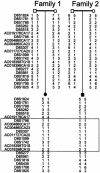Identification of microcephalin, a protein implicated in determining the size of the human brain
- PMID: 12046007
- PMCID: PMC419993
- DOI: 10.1086/341283
Identification of microcephalin, a protein implicated in determining the size of the human brain
Abstract
Primary microcephaly (MIM 251200) is an autosomal recessive neurodevelopmental condition in which there is a global reduction in cerebral cortex volume, to a size comparable with that of early hominids. We previously mapped the MCPH1 locus, for primary microcephaly, to chromosome 8p23, and here we report that a gene within this interval, encoding a BRCA1 C-terminal domain-containing protein, is mutated in MCPH1 families sharing an ancestral 8p23 haplotype. This gene, microcephalin, is expressed in the developing cerebral cortex of the fetal brain. Further study of this and related genes may provide important new insights into neocortical development and evolution.
Figures






References
Electronic-Database Information
-
- Genome Database, http://www.gdb.org/
-
- Human Genome Project Working Draft at University of California Santa Cruz, http://genome.cse.ucsc.edu/
-
- MRC Human Genome Mapping Project Centre, http://www.hgmp.mrc.ac.uk/
-
- NCBI, http://www.ncbi.nlm.nih.gov/ (for microcephalin cDNA, AK022909, AX087870; genomic, AX087869; protein CAC34661; ANGPT2, NM_001147; DNA topoisomerase II binding protein, BAA34202. Mouse microcephalin cDNA, AY070216)
References
-
- Angevine JB Jr, Sidman RL (1961) Autoradiographic study of cell migration during histiogenesis of cerebral cortex in the mouse. Nature 192:766–768 - PubMed
-
- Bundey S (1992) Microcephaly. In: Genetics and neurology: genetics in medicine and surgery. Churchill Livingstone, Edinburgh, pp 20–24
-
- Cox KH, DeLeon DV, Angerer LM, Angerer RC (1984) Detection of mRNAs in sea urchin embryos by in situ hybridization using asymmetric RNA probes. Dev Biol 101:485–502 - PubMed
-
- Dixon J, Hovanes K, Shiang R, Dixon MJ (1997) Sequence analysis, identification of evolutionary conserved motifs and expression analysis of murine tcof1 provide further evidence for a potential function for the gene and its human homologue, TCOF1. Hum Mol Genet 6:727–737 - PubMed
Publication types
MeSH terms
Substances
Associated data
- Actions
- Actions
- Actions
- Actions
- Actions
Grants and funding
LinkOut - more resources
Full Text Sources
Other Literature Sources
Molecular Biology Databases
Miscellaneous

